Summary of May itinerary in Japan (Kumamoto trip)
I travelled to Kumamoto Prefecture (partly Fukuoka Prefecture) from Tuesday, 17 May to Thursday, 19 May. On this trip I was able to eat a lot of seasonal seafood and local cuisine and visit wonderful tourist attractions such as World Heritage Sites, national treasures and national important cultural properties. As my main objective was to eat local cuisine, I was able to eat more local dishes than I have on previous trips. I would strongly recommend this May Japan itinerary to everyone. A summary of this trip and some notes are reported below.
Table of contents
1.”100 best of local dishes” and “Local dishes loved by the nation” by this itinerary in Japan
2. Seasonal “PRIDE FISH” by this itinerary in Japan
3. Travel precautions for itinerary in Japan
As I repeat every time, this itinerary was also created with the purpose of “eating out seasonal fish and shellfish and local dishes.” Food is the highest priority, and tourist destinations are the second priority. However, I aimed to visit as many tourist spots as possible, such as World Heritage Sites, national treasures and national important cultural properties.
1.”100 best of local dishes” and “Local dishes loved by the nation” by this itinerary in Japan
Kumamoto Prefecture : Horse sashimi, Ikinari dago, Karashi Renkon, Taipien
On this trip to Kumamoto, I was able to eat all of the “100 best of local dishes” and “Local dishes loved by the nation” selected by the Ministry of Agriculture, Forestry and Fisheries from Kumamoto Prefecture. From the “100 best of local dishes”, I could eat horse sashimi, Ikinari dago, Karashi Renkon, and from the “Local dishes loved by the nation”, I could eat Taipien. By the way, there are only 5 prefectures in Japan where 3 dishes are selected in the “100 best of local dishes”. Kumamoto Prefecture is rich in local cuisine.
Horse sashimi is probably the most famous local dish in Kumamoto prefecture. We can now eat horse sashimi in Tokyo as well, but mainly lean meat. In Kumamoto prefecture, in addition to lean meat, we can eat deliciously other parts such as marbled meat and mane meat. The horse sashimi platter I ate this time was also very delicious. Horse meat is also called Sakura (cherry) meat. This is because it is delicious to eat a horse in the spring when the cherry blossoms bloom after fully fertilized in winter, and the cut end becomes cherry-colored. Horse meat hot pot is called Sakura hot pot.

This was my first time eating “Ikinari dago”. It may be that I don’t like sweets very much, but I didn’t know that ikinari dago existed in the first place. The word “ikinari” in “Ikinari dago” means “easy, quick and immediate” in the Kumamoto dialect. “Dago” is also a Kumamoto dialect word for dumplings. The sweetness of the sweet potato, the sweetness of the red bean paste and the saltiness of the dough made for a very tasty dango.
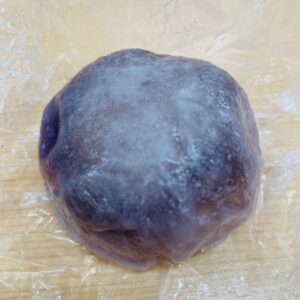


Karashi Renkon (Spicy lotus root), together with horse sashimi, is a nationally famous local dish of Kumamoto Prefecture. There are very few spicy local dishes in Japan, and few spicy dishes have been selected for the “100 best of local dishes” and the “Local dishes loved by the nation”. Among them, Kumamoto Prefecture’s spicy lotus root and Fukuoka Prefecture’s spicy cod roe can be regarded as the two most spicy local dishes. When I researched the origin of spicy lotus root, I was surprised to learn that it was originally a tonic dish for the feudal lords. The spicy lotus root we ate this time was also very spicy and delicious.



Taipien is another famous Kumamoto dish. Taipien was originally a local dish in Fuzhou, Fujian Province, China. It is a noodle dish with fried prawns, squid, pork, Chinese cabbage, etc. in a vermicelli soup, topped with a fried egg. Taipien in Kumamoto is said to have been introduced to Japan by overseas Chinese merchants during the Meiji era (1868-1912). Taipien can be found in many Chinese restaurants in Kumamoto. What is strange is that, Nagasaki champon, which was introduced from China like Taipien, can be eaten throughout Japan, whereas Taipien has hardly spread throughout the country. The aforementioned spicy lotus root is also not as widespread nationwide as spicy cod roe. If you know why Kumamoto cuisine other than horse sashimi is unlikely to become a national dish, please tell us.



In addition to the “100 best of local dishes” and “Local dishes loved by the nation”, I was able to eat many other Kumamoto local dishes this time. I was able to eat tsubon-jiru soup, grilled sweetfish Kanro-ni (stewed in soy sauce and sugar), Whole Konoshiro (dotted gizzard shad) Sushi, miso-pickled tofu, shaku and Ichimonji no guruguru from the “Our Regional Cuisines” selected by the Ministry of Agriculture, Forestry and Fisheries.
“Tsubon-jiru soup” and “Miso-pickled tofu” were served at dinner at Hitoyoshi Ryokan, where I stayed on the first day. “Tsubon-jiru soup” is a soup with a lot of ingredients such as chicken, kamaboko (boiled fish paste), taro, burdock, carrot, and radish. It is a local dish in the Kuma area. Tofu marinated in miso is a local delicacy of Itsuki-mura, near Hitoyoshi City. It is also called ‘Yama-uni Tofu’ because its texture resembles that of a sea urchin. The “Tsubon-jiru soup” has a simple taste and the “Miso-pickled tofu” is a delicious food that goes very well with Kuma shochu.






“Grilled sweetfish Kanro-ni” was served at Yorifuji, a renowned ayu restaurant in front of Yatsushiro Station. “Yorifuji” is famous for offering the ekiben “Ayuya Sandai”. “Ayuya Sandai” is a very popular ekiben that won the first place in the popular ekiben ranking in Kyushu for three consecutive years. “Grilled sweetfish Kanro-ni” is famous in Kumamoto Prefecture because the Kuma River, one of Japan’s three most rapid rivers, is a sweetfish production area. At Yorifuji, I had grilled sweetfish and Ko-Uruka in addition to “Grilled sweetfish Kanro-ni”. “Ko-Uruka” is fermented food made from sweetfish egg and soft roe (milt). Kanro-ni and grilled sweetfish that I ate at “Yorifuji” was by far the most delicious sweetfish in my life.


“Whole Konoshiro (dotted gizzard shad) Sushi” and “Shaku” were served at Nishiki Sushi in Shiranui Town, Uki City. Nishiki Sushi is a Michelin Guide Bib Gourmand restaurant. “Whole Konoshiro Sushi” is especially eaten in the coastal areas of the Yashiro Sea, Amakusa Nada, and the Ariake Sea. The first time I ate “Whole Konoshiro Sushi”, the effect of vinegar was exquisite and it was very delicious. Kumamoto Prefecture is the second largest catch of dotted gizzard shad in Japan. The first place is Chiba prefecture (2020). In particular, in Uki City, where the catch of dotted gizzard shad is high, they have created a character called “Konoshiro Bucho (Manager)” to appeal to the gourmet highway called “Uki-Uki Konoshiro Highway”.
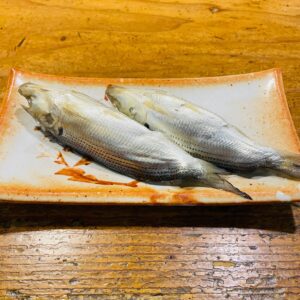





Ichimonji from “Ichimonji no guruguru” is another name for the Japanese common green onion. Guruguru is named after the boiled white root of Ichimonji with the green onion wrapped around the shaft. It is eaten with vinegared miso or spicy miso. The balance between the Japanese common green onion and the vinegared miso was very good.



2. Seasonal “PRIDE FISH” by this itinerary in Japan
Kumamoto Prefecture: Nothing
I was not able to eat “PRIDE FISH” on this trip to Kumamoto. There are only three types of “PRIDE FISH” in Kumamoto Prefecture in one year. Three types of “PRIDE FISH” is the fewest among all prefectures. In May when I travelled, only Kumamoto asari clams (season: March – May) were listed as “PRIDE FISH”.
Earlier this year, the issue of disguised origin of Kumamoto asari clams was widely reported, as more than 90% of foreign asari clams were shipped as “from Kumamoto”. Because of these disguise problems, I don’t know if asari clams were not seen on menus in Kumamoto. However, this time I did not see any Kumamoto asari clams and could not eat “PRIDE FISH”. It was very disappointing.
“PRIDE FISH” is selected by Japan Fisheries Co-operative.
3. Travel precautions (local trains) for itinerary in Japan
I write the same thing every time, but it’s important, so I repeat it. This time as well, the rule of travel is an environment-friendly trip that uses only public transportation including rental bicycles. This time, it was a trip with a lot of rental bicycles, such as running 42km from the downstream to the upstream of the Shimanto River.
Again, this is a reconfirmation, but traveling by public transport has far less CO2 emissions than traveling by car. For example, according to data from the Ministry of Land, Infrastructure, Transport and Tourism, CO2 emissions when one person travels 1 km are 130 g for automobiles, 98 g for aircraft (75% for automobiles), 57 g for buses (44% for automobiles), and 17 g for railways (13% for automobiles).
It was difficult to understand how to get on and off the one-man operated train this time as well. On this trip, the ‘JR Misumi Line’ and the ‘JR Kagoshima Line’ (I rode from Misumi Station to Omuta Station) were one-man trains.
When getting on and off a one-man operated train, you need to press a button to open the door. Also, when you get on the train, you will get a numbered ticket, and when you get off, you will put the numbered ticket and money in the fare box and get off.
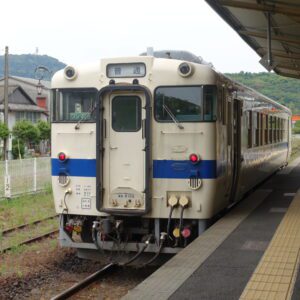



There was a note on the boarding gate about how to get on and off, and a poster was posted inside the train, but it was only in Japanese. Railroad operators and tourist associations should be responsible for providing guidance in foreign languages.
In the case of a one-man operated train, it is safe to always get on the first car. In JR, you usually get on from the rear door of the first car and get off from the front door. Be sure to remember the train boarding / alighting rules when traveling in rural areas of Japan. However, it depends on the railway operator whether you ride from the front door or the rear door of the first car.
Please see the detailed notes written on each travel day.
4. Travel in a light style
Again, I sent my clothes and power cord to my accommodation in advance for this trip, and enjoyed the “luggage-free trip” every day. After all, it is very easy to travel in a light style like taking a walk. Being able to act immediately after arriving by train or plane is important for effective use of time. Again, on the last day of the trip, I sent the clothes I wore during the trip to the laundry agent and did not have to do the laundry. I want everyone to experience the comfort of a “luggage-free trip”.
5. May 17 (Tuesday) Day 1
I visited Aoi Aso Shrine for the first time in Hitoyoshi city tour. Aoi Aso Shrine was founded in 806. The existing main hall, corridor, hall of offerings, hall of worship and tower gate were built from 1610 to 1613. It was built by the founder of the first feudal lord of the Hitoyoshi domain, Nagatsune Sagara, and his chief retainer, Seibei Sagara. It is rare in Japan as a whole that a series of shrines were built at the same time, and it is very valuable. The most characteristic feature is the thatched roof with a high roof and a steep slope. Such an architectural method is unique to the Hitoyoshi Kuma region.
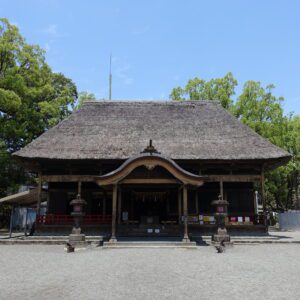

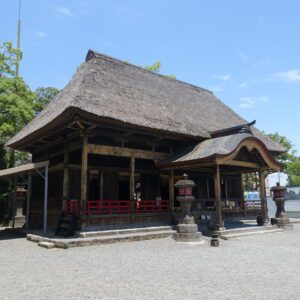

Aoi Aso Shrine was designated as a national treasure in 2008. Aoi Aso Shrine is the first thatched roof shrine and temple to be designated as a national treasure and is also the only national treasure in Kumamoto Prefecture. This is the second national treasure at a shrine in Kyushu after the main shrine of Usa Hachimangu in Oita prefecture.
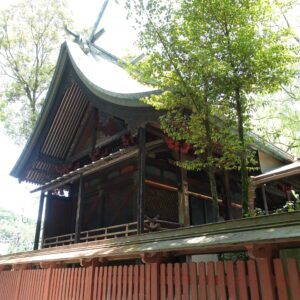

At Aoi Aso Shrine, the worship hall of the national treasure was flooded on the floor during the 2020 Kyushu floods, and the balustrade of Misogi Bridge was damaged. The balustrade is still under repair.
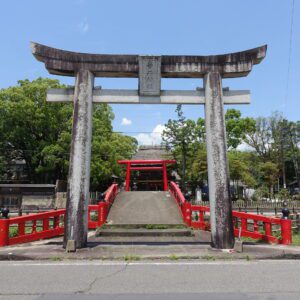

I was impressed by the wonderfulness of the thatched roof gate. It is a 12-meter-high Zen Buddhist style and Momoyama style. Although some of the colors have faded over time, it still conveys the wonderful colors of the past.


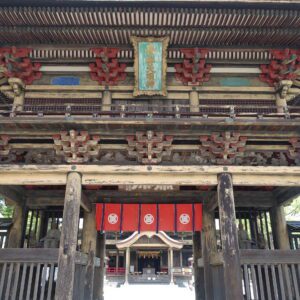



Next to Aoi Aso Shrine, I went to Oikami Shrine. Oikami Shrine is a national important cultural property.
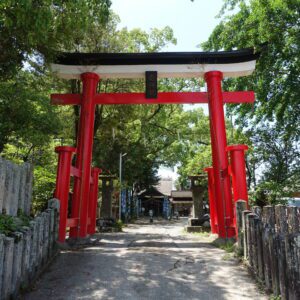

Oikami Shrine was built in 807. The current shrine was built in 1628 by Nagatsune Sagara, the first feudal lord of the Hitoyoshi domain. It retains the Momoyama period-style building method. It is also the battlefield of the Satsuma Rebellion.
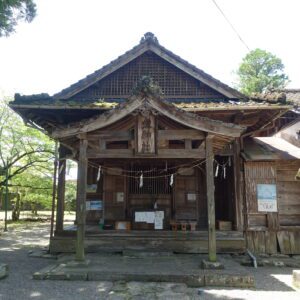

Next to Oikami Shrine, I went to Iwaya-kumanoza Shrine. Iwaya Kumanoza Shrine was founded by Nagayori Sagara, the first owner of Sagara family, soliciting Kumano Sansho Gongen (god of the three main Kumano shrines) around 1230. It is a national important cultural property.
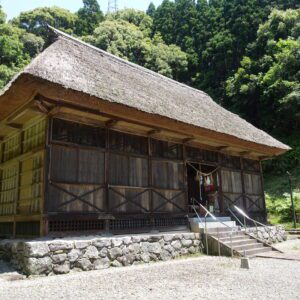

The three main shrines of Iwaya-kumanoza Shrine are believed to have been built in 1727. The stone torii gate was donated in 1701 and is the only one in the Kuma region in the form of a two-part torii gate with a chigo pillars.
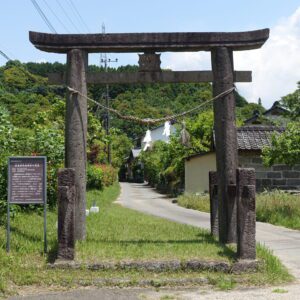

Hitoyoshi Station has the only active stone railway garage in Japan. The stone garage was built in 1911.


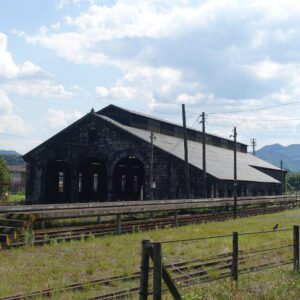

At the end of the sightseeing on May 17, I went to Yamada Daio Shrine. The main shrine of Yamada Daio Shrine is a national important cultural property built in 1546. Yamada Daio Shrine is one of the few buildings dating back to the Middle Ages. It looks more like a medieval farmer’s house than a shrine.


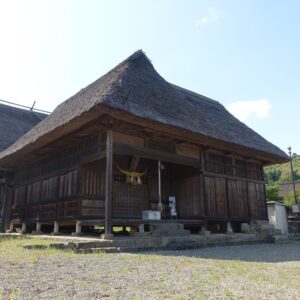



Yamada Daio Shrine is a shrine that enshrines the spirit of Hirakawa Fujitaka, who was the head of Nagayoshisho Yamadamura. Hirakawa family is “Gozoku (baronial family)” who was destroyed by Nagayori Sagara in the “Battle of Chishikibaru”. “Chishikibaru” is written as a field filled with blood. As the name implies, it is estimated that the battle between them was quite horrific. Yamada Daio Shrine and Arata Daio Shrine were built to mourn the spirits of the Hirakawa clan. The name of the Daio (Great King) given to the shrine is the name given to the “Gozoku (baronial family)”.
Meals
The first meal of this trip to Kumamoto was at “Uemura Unagiya“. “Uemura Unagiya” is a long-established eel restaurant that was founded in 1908 and has a history of more than 100 years. It has also been selected as one of the “100 famous tabelog restaurants”. It is the only “100 famous tabelog restaurants” in Hitoyoshi City.


I ordered “Uzaku (vinegared eel and cucumber)” (Yen 800), “Eel Liver” (Yen 1,000), and “small Unaju (broiled eel served over rice in a lacquered box)” (Yen 3,200) at “Uemura Unagiya”. The taste of “Uzaku” was above average, but the “liver of eel” and “shige of eel” were excellent.
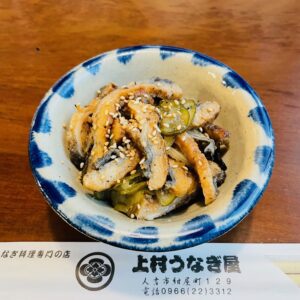

As you can see in the picture, the volume of “eel liver” was as large as 20 eels. I think it’s the first time in my life that I’ve eaten so many eel livers. I love eel liver so I was very happy.


At “Uemura Unagiya”, they swims eels in fresh water for about 5 to 10 days. They cleaned the eels after receiving an order, and grilled over charcoal, and served with a secret sauce. Since eel swam in fresh water, it has no odor. There are many “eel restaurants” in Hitoyoshi City because eels were caught in the Kuma River. There are 5 “eel restaurants” registered in “Tabelog” in Hitoyoshi City alone. At present, the catch of natural eels on the Kuma River has decreased, so it seems that “Uemura Unagiya” uses eels from Kagoshima prefecture.


After sightseeing in Hitoyoshi, I had a tasting of rice shochu at Sengetsu Shuzo. Sengetsu Shuzo is a long-established rice shochu maker founded in 1903.
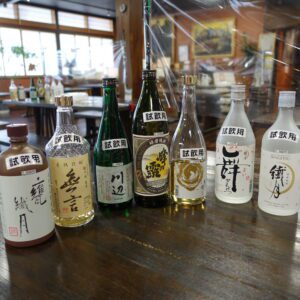

Hitoyoshi City has a history of rice shochu for about 500 years. There seems to be a record in 1546 that Francis Xavier was informed that “people are drinking rice shochu in Japan.” On the other hand, the production of Imo Shochu (spirit distilled from potatoes) has been since 1782. Therefore, the oldest shochu in Japan is rice shochu.
Sagara family, the feudal lord of the Hitoyoshi domain, was actively trading with Southeast Asia and mainland China, and it is said that the introduction of distillation technology was the catalyst for making shochu. There are still 27 shochu breweries in the Hitoyoshi region. Rice shochu produced in the Hitoyoshi Basin is called “Kuma shochu” and has been designated as a protection of the production area label based on the TRIPS Agreement (Agreement on Trade-related Aspects of Intellectual Property Rights) of the World Trade Organization. There are only a few alcoholic beverages that have been designated as protected by the origin label, such as Scotch whiskey and Bordeaux wine, and “Kuma Shochu” is a globally recognized brand.
The biggest difference between rice shochu and sake made from the same rice is “spirits or fermented liquor”. Sake is a “fermented liquor” made by fermenting rice, which is the raw material. On the other hand, rice shochu is a “spirits” that adds a process called distillation to the brewed sake. The alcohol content of rice shochu and sake is also different. The alcohol content is 22 degrees or less for sake and 45 degrees or less for rice shochu.
In the Hitoyoshi Basin, which used to be rice, the warm climate is not suitable for sake brewing, and it is estimated that rice shochu was made instead of sake. As the word “Kan zukuri (cold brewing)” is used in sake, it is said that the most suitable for sake brewing is the cold season from December to February. This is the reason why sake production is low in warm Kyushu and Okinawa.
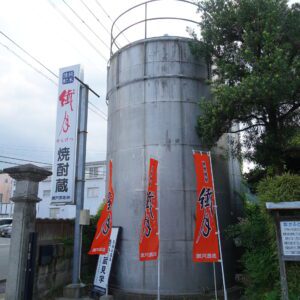

I don’t know if it’s true or false, but the reason why a lot of rice shochu was produced in the Hitoyoshi Basin is that the Hitoyoshi domain avoided the inspection of the shogunate, and the actual rice production is much higher than the nominal rice production. It is said that this is because it was possible to make rice shochu. The rice production of the Hitoyoshi domain was 22,000 koku, but it seems that it was actually 100,000 koku. It is said that this is because the Hitoyoshi basin is a gourd-shaped basin, and a wide basin spreads further into the land where the shogunate’s inspection is conducted to produce rice. Therefore, rice shochu could be produced from the surplus rice of the Hitoyoshi clan, but other clan in Kyushu produced shochu using sake lees called “Kasutori shochu”. I also heard these stories from the locals twice on this trip to Hitoyoshi.
In this way, the history is long and the intensity of feelings to rice shochu in the Hitoyoshi Basin are strong. Rice shochu is dedicated at Aoi Aso Shrine, a national treasure.
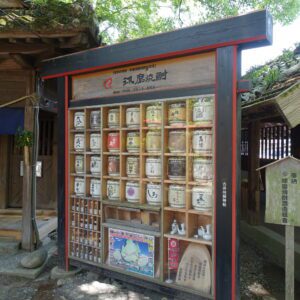

I tasted and bought my favorite rice shochu “Mugon” and drank it at “Hitoyoshi Ryokan” at night. The taste and color were so different from the rice shochu I had ever drank that I thought it was whiskey rather than shochu.
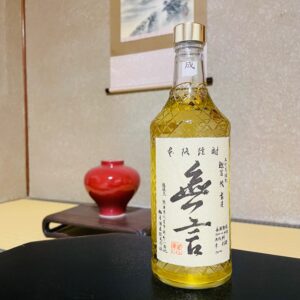

After enjoying the tasting at Sengetsu Shuzo, I had dinner at the Hitoyoshi Ryokan where I stayed. The dinner at “Hitoyoshi Ryokan” was very satisfying with luxurious meals such as local dishes.
First of all, the appetizer was small bowls that were beautifully presented like “Bamboo shoots and squid with bud dressing” and “Japanese butterbur with white miso”. Everything was delicious, but especially the “Yama-uni (Mountain sea urchin) Tofu”, a local dish of Itsuki Village near Hitoyoshi City, was excellent.



“Slices of Yamame washed in cold water (sashimi)” and “Yamame salt-grilled” were also the best. Yamame is a river-remaining type (land-sealed type) of cherry salmon that spends its entire life in the river. The Yamame is called the “queen of mountain torrent” because of its beauty.


“Taro steamed buns with yuba ankake”, “Chawan-mushi (a savory steamed egg custard with assorted ingredients)”, “Fried bamboo shoots and edible wild plants tempura” were also very delicious. I was very satisfied with my meal so far, and then I had a hot pot dish.






The hot pot dishes were “Black Berkshire pork in Kuma” and “Tamogi Mushroom (golden oyster mushroom)”. “Tamogi mushroom” is a mushroom of the family of Hiratake. It has a bright yellow umbrella and is characterized by being rich in ergothioneine (an antioxidant component) that suppresses aging. “Tamogi mushroom” seems to be eaten in China and Taiwan. In Japan, the main production areas of “Tamogi mushroom” are Hokkaido and Tohoku, but it is also produced in Asagiri Town, Kumamoto Prefecture, near Hitoyoshi City.
A picture named after “SL Hitoyoshi” running between Kumamoto Station and Hitoyoshi Station was drawn on the pot. “SL Hitoyoshi” currently operates only between Kumamoto Station and Tosu Station due to 2020 Kyushu floods.




At the end of the meal, I had “Pot rice with local chicken, mushrooms and thinly deep-fried tofu” and “Tsubon soup”. Both “Pot rice” and “Tsubon soup” were very delicious dishes.





The dessert was “Pear sorbet and Kuma chestnut Mont Blanc monaka”. I thought this dessert was of such high quality that it would be quite talked about if it was sold at a cake shop or cafe. It was really excellent.


All the dishes at “Hitoyoshi Ryokan” were delicious and I left the dinner venue with great satisfaction. Also, at the dinner at “Hitoyoshi Ryokan”, the “Okami (landladies)” greeted each table, and the maids also provided a friendly and pleasant service, which made me feel at ease.
“Hitoyoshi Ryokan” is a national registered tangible cultural property inn. “Hitoyoshi Ryokan” was severely damaged by 2020 Kyushu floods, but it was completely restored and the entire building was reopened in May this year. It was good to see the power of reconstruction of “Hitoyoshi Ryokan” without any trace of disaster now.
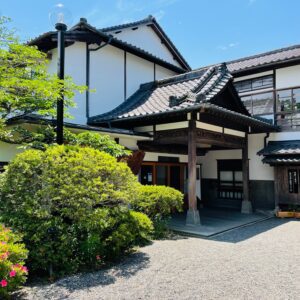

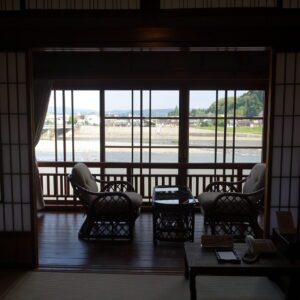

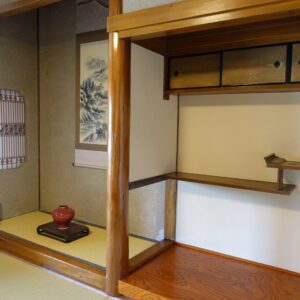

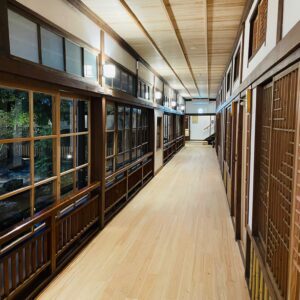

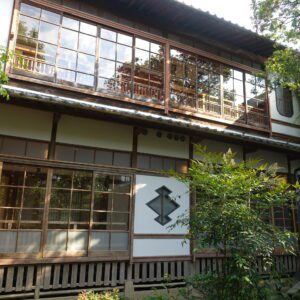

Important Points
It should be noted that the nearest airport to Hitoyoshi, Kumamoto Prefecture, is Kagoshima Airport. The journey from Kagoshima Airport to Hitoyoshi Station takes 1 hour 10 minutes to 1 hour 20 minutes. On the other hand, it takes 2 hours to 2 hours 20 minutes from Kumamoto Airport to Hitoyoshi Station. Kumamoto Airport also requires about one hour to get to Kumamoto Station, making it one of the airports with the worst access to the city in Japan.
Note that the journey from Fukuoka Airport, which has the best access to the city in Japan, to Hitoyoshi Station takes 2 hours 20 minutes to 2 hours 30 minutes using the Shinkansen bullet train, which is almost the same as the time required from Kumamoto Airport. However, the fare from Fukuoka Airport to Hitoyoshi Station is approximately three times higher than the fare from Kumamoto Airport to Hitoyoshi Station.
6. May 18 (Wednesday) Day 2
At Shin-Yatsushiro Station, there is Kumamon with a fireworks shaku ball. Kumamon with this shaku ball is named after the “Yatsushiro National Fireworks Competition Festival“. The “Yatsushiro National Fireworks Competition Festival” is held in October every year.
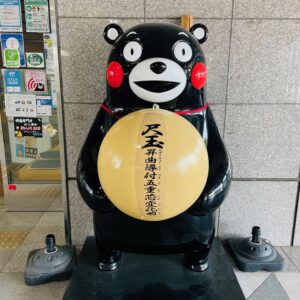

In Yatsushiro City, there are more than 100 Kumamon in the city. There is also a Kumamon map. I didn’t know in advance that there were so many Kumamon in Yatsushiro, but I did see so many Kumamon in the city. If you like Kumamon, please visit Yatsushiro.
There was Kumamon in front of Yatsushiro station. I thought it was Kumamon with a yellow ball, but the yellow ball is actually Banpeiyu (Citrus grandis). Banpeiyu is the largest citrus fruit in the world, which is a specialty of Yatsushiro.
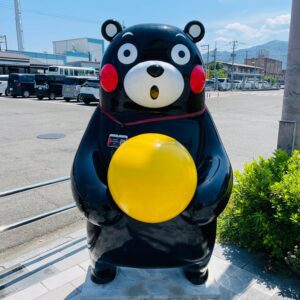

After having an excellent lunch near Yatsushiro Station, I rented a bicycle and went to “Kumamon Port Yatsushiro“. It is about 9km from Yatsushiro Station to “Kumamon Port Yatsushiro“.
“Kumamon Port Yatsushiro” was completed in March 2020 as a base for accepting international cruise ships. It was completed at the timing when the spread of the COVID-19 began, and it was the opening at the very worst timing. “Kumamon Port Yatsushiro” has a unique park with the theme of Kumamon as a place of relaxation for local residents. There are 84 Kumamon in “Kumamon Port Yatsushiro”.
“Kumamon Port Yatsushiro” is closed every Wednesday. I didn’t think there was a holiday because it was a park, so I went to “Kumamon Port Yatsushiro” by bicycle, but I couldn’t go inside because of the “closed day” sign.
It was a pity that the park was closed, but I was able to take a few pictures of Kumamon from the outside, so I will post a picture. I think “Kumamon Port Yatsushiro” is the best park for Kumamon lovers. Admission is free.
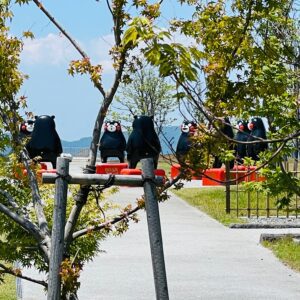

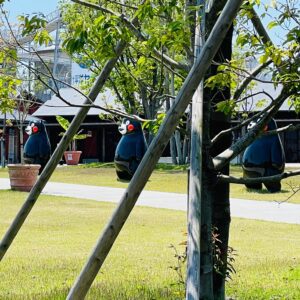

From “Kumamon Port Yatsushiro”, I went to “Former Gunchiku-Shinchi Kogo sluice gate”, which is a national important cultural property.
“Former Gunchiku-Shinchi Kogo sluice gate” is a sluice gate set up in the reclamation project “Gunchiku-Shinchi” and was built in 1900. The length of the sluice gate is 31.8m, and the width of the sluice gate is 8.3m.
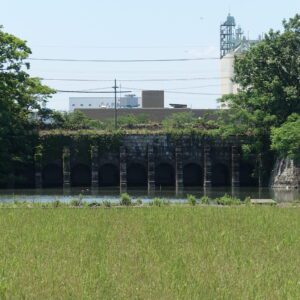

The “Yatsushiro Municipal Museum” was designed by world-famous architect Toyo Ito (US Pritzker Prize winner).
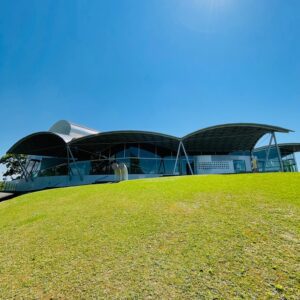



Kumamon wearing a mask stood in front of the “Yatsushiro Municipal Museum”. In addition, there was Kumamon with a book in the Yatsushiro City Library diagonally in front of the museum.


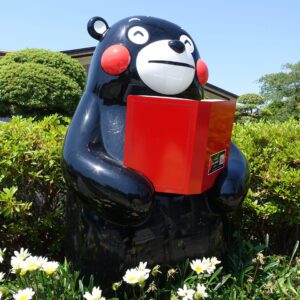

Next, I enjoyed the Japanese garden at Shohinken in front of the “Yatsushiro Municipal Museum”. Shohinken is a daimyo garden built in 1688 by Naoyuki Matsui, the owner of Yatsushiro Castle, and is a national scenic spot.
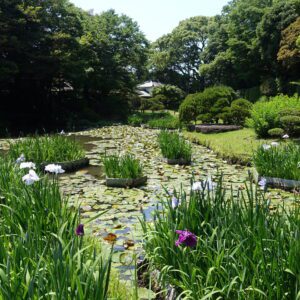

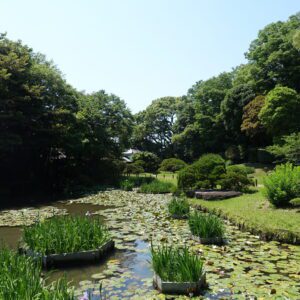

Higo Japanese irises were just beginning to bloom. The only exception is the Higo Japanese irises of Shohinken, which were allowed to be transplanted by the full moon party.
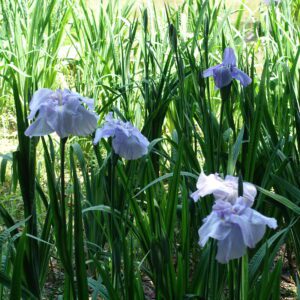

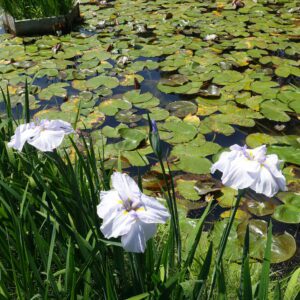

The current owner of the Matsui family still lives in Shohinken. Therefore, we cannot tour the house.
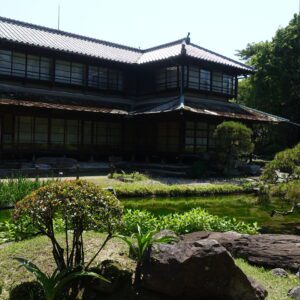

It is designated as a national historic site as “Yatsushiro Castle Ruins and Yatsushiro-gu”.
Yatsushiro Castle was completed in 1622. It was extremely unusual for two castles to be found in the same clan after the Law of One Castle per Province (1615). It is generally accepted that the reason why the existence of two castles (Kumamoto Castle and Yatsushiro Castle) was allowed in the Kumamoto Domain is to prepare for the Satsuma Domain and Hitoyoshi Domain. The main castle of Yatsushiro Castle had a large castle tower on the 5th floors and a small castle tower on the 2nd floors.
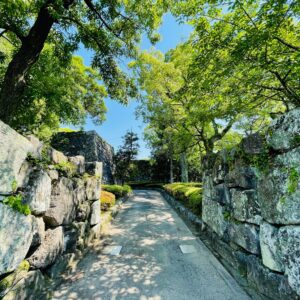



Yatsushiro-gu was founded in 1884. Located on the site of Yatsushiro Castle, Prince Kaneyoshi, the prince of Emperor Go-Daigo, is the main deity. He fought against the Ashikaga army in Kyushu.




I happened to find Ryuo Shrine on the way from Yatsushiro Castle Ruins to Shunkoji Temple. It is about 5 minutes by bicycle (1.5km) from the Yatsushiro Castle Ruins.
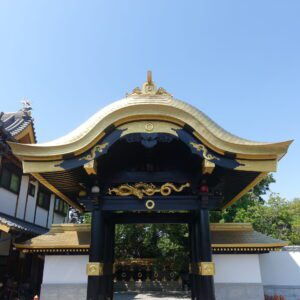



Ryuo Shrine is rare as a shrine and is made only in black and gold. It seems to be a “spiritual hot spot in Yatsushiro” that many celebrities are visiting.


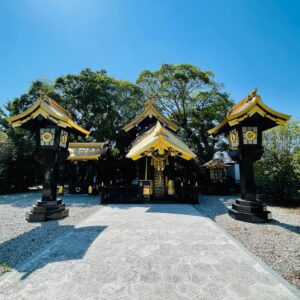

Originally, I like the calm shrines that are unique to Japan, but I thought that such a strange shrine would be nice once in a while. I didn’t know the existence of Ryuo Shrine at all, and I was surprised to find it by chance.


Next to Ryuo Shrine, I went to Shunkoji Temple. Shunkoji is a family temple of the Matsui family, the owner of Yatsushiro Castle. This land became a battlefield in the Satsuma Rebellion in 1877, with bullet holes left in places. Shunkoji is a tangible cultural property designated by Yatsushiro City.


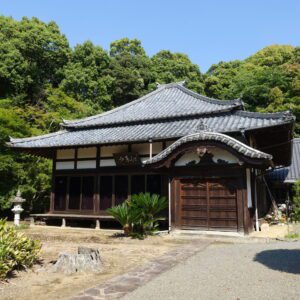

Hydrangea was beautifully blooming in the precincts of Shunkoji Temple. Hydrangea is one of my favorite flowers.




As the last place for sightseeing in Yatsushiro, I went to Yatsushiro Shrine (Myoken Shrine). Yatsushiro Shrine (Myoken Shrine) is said to be one of the three major Myoken in Japan, along with Soma Myoken in Fukushima Prefecture and Nose Myoken in Osaka Prefecture.
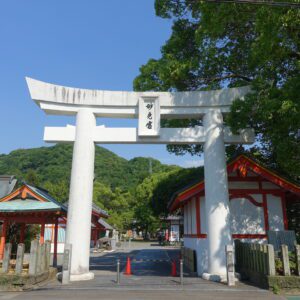

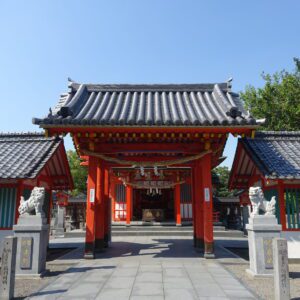

Myoken religion was introduced to Japan as a type of Buddhism by combining The Bodhisattva religion, which originated in India, and the Taoist North Star / Big Dipper religions in China. The Myoken religion was introduced to Japan in the 7th century (Asuka period), and it is a religion from a long time ago. “Mtyoken” means “excellent eyesight” and means a person who sees good and evil and truth well.
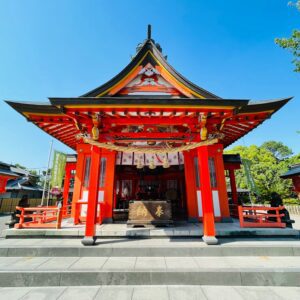

The Yatsushiro Shrine (Myoken Shrine) was built in 795 and is a historical shrine. The Myoken Festival at Yatsushiro Shrine (Myoken Shrine) is one of the three major festivals in Kyushu and is designated as a national important intangible folk cultural property as a “Myoken Festival”. In addition, it is registered as an intangible cultural heritage of the United Nations Educational, Scientific and Cultural Organization (UNESCO) as one of the “Yama, Hoko, Yatai, float festivals in Japan“. The building is a tangible cultural property designated by Kumamoto Prefecture.
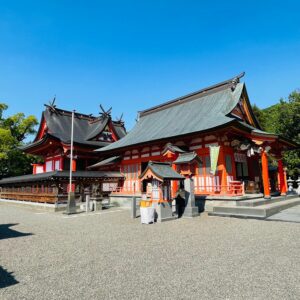

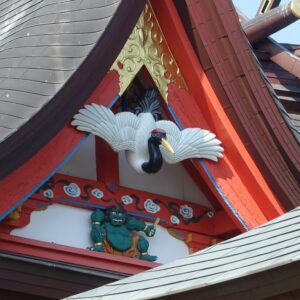

After visiting Yatsushiro Shrine (Myoken Shrine), I returned to Yatsushiro Station. Along the way, I saw Kumamon in a white coat.
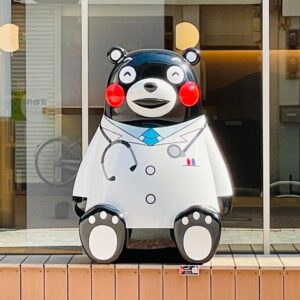

The “Kumamon Train” was stopped at Hisatsu Orange Railway Yatsushiro Station next to JR Yatsushiro Station. First, the light blue “Kumamon Wrapping Train No. 1” arrived, and then the orange “Kumamon Wrapping Train No. 2” arrived and connected with No. 1. The Hisatsu Orange Railway has only No. 1-3 “Kumamon Trains”, and I was very lucky to be able to see Nos. 1 and 2 of them by chance.
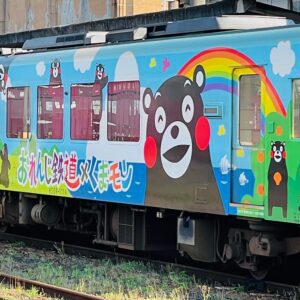

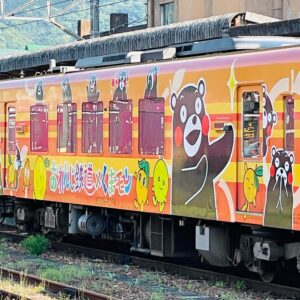

The Shiranui Sea spread out in front of the Shoukinkan where I stayed. The Shiranui Sea, like the Ariake Sea, was a fairly shallow sea. I didn’t know it at all, but Shiranui is a type of mirage that appears around August 1st of the lunar calendar, and is a type of ghost fire. The light source of Shiranui was found to be fishing fire. However, nowadays, due to the existence of lamps on the opposite bank such as Yatsushiro and the pollution of seawater, it seems that Shiranui can hardly be seen.
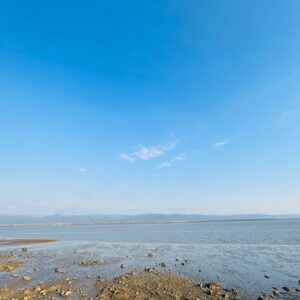

Meals
Breakfast on May 18th was served at the accommodation “Hitoyoshi Ryokan“. I love breakfast at hot spring inns. Even though it’s breakfast, it’s great to be able to eat many kinds of side dishes. Also, the color of the small bowl containing many kinds of side dishes is beautiful.


The breakfast at Hitoyoshi Ryokan was one of the best breakfasts I have ever had at a hot spring inn. I ate dried sweetfish for the first time. The Kuma River, which runs beside Hitoyoshi Ryokan, is famous for catching delicious sweetfish. The opening date for sweetfish fishing is June 1, so it’s a pity that I could only eat dried sweetfish this time. Next time, I wanted to revisit Hitoyoshi during the sweetfish fishing season.


Arrived in Yatsushiro City and had lunch at “Yorifuji” in front of Yatsushiro Station. “Yorifuji” is famous for offering the ekiben “Ayuya Sandai”. “Ayuya Sandai” is a very popular ekiben that won the first place in the popular ekiben ranking in Kyushu for three consecutive years. This ekiben is a bento box with a whole Kanro-ni (boiled in a syrup or grilled) of Kuma River’s natural sweetfish that is softly simmered to the bones on top of rice cooked with the soup stock of grilled sweetfish.


I ate “Kanro-ni / Grilled set meal” (Yen 2,600) and “Ko-Uruka” (Yen 600) at “Yorifuji”. At the ekiben “Ayuya Sandai”, you have to choose either Kanro-ni or grilled sweetfish, but at “Yorifuji” you can eat both. Kanro-ni of sweetfish is simmered softly to the bone, so you can eat whole sweetfish.
In addition, you can enjoy the same taste as raw sweetfish by thawing and grilling frozen sweetfish caught in the previous season. Rice cooked with the soup stock of sweetfish has a gentle seasoning and goes very well with Kanro-ni. Kanro-ni and grilled of sweetfish that I ate at “Yorifuji” was by far the most delicious sweetfish in my life. It was delicious that I wanted to revisit Yatsushiro just to go to “Yorifuji”.


“Ko-Uruka” is fermented food made from sweetfish egg and soft roe (milt). It’s salty, but it’s not so salty compared to the fermented squid. I ate “Ko-Uruka” for the first time, and it was a delicacy with an exquisite taste. This “Ko-Uruka” has become a delicacy that I definitely want to eat when I return to “Yorifuji”. The next time I eat it, it’s a delicacy I’ll want to eat with sake.


I had dinner at “Nishiki Sushi” next to “Kappo Ryokan Shoukinkan” where I stayed. “Nishiki Sushi” is a well-known restaurant selected by the Michelin Guide Bib Gourmand. I was very satisfied with the fresh seafood, mainly local fish, at “Nishiki Sushi”. May 18th was a perfect delicious meal day with everything from breakfast to dinner. I think I’ve been able to eat the perfect delicious meal for all three meals only a few times in my life. It was a really happy day.
“Kappo Ryokan Shoukinkan” is run by the son of the master of “Nishiki Sushi”. Even if we drink delicious sake at “Nishiki Sushi” and get drunk, we can rest assured that we only sleep at the “Shoukinkan” next door. It’s also nice to feel comfortable that we don’t have to move after drinking alcohol.
I first ordered a “sashimi platter” of local fish at “Nishiki Sushi”. The contents were spotted Knifejaw, butterfish, and bigfin reef squid. The season for spotted Knifejaw in Kumamoto is early summer. It is delicious in earnest from May and June. Butterfish is also in early summer. The season for bigfin reef squid in Kumamoto is April-June. All the fish and shellfish included in the “sashimi platter” were seasonal and were very delicious.


Next, I ate the boiled “Shaku” recommended by the master. “Shaku” is officially called Japanese mud shrimp. I thought it was a mantis shrimp because it has a similar shape, but it is a completely different kind of crustacean. “Shaku fishing” is a method of putting a brush in the burrow that appeared after the tide has subsided and catching the Shaku that came out to the entrance of the hole one by one. The master and the okami (landladies) of “Nishiki Sushi” taught me. There is an interesting way of fishing.



Next to “Shaku”, I had boiled Japanese squid (Loliolus japonica) and Little cuttlefish (Bottle-tailed cuttlefish). Both are small squids. In particular, Little cuttlefish (on the left side of the photo) is a very cute squid with a size of about 3-4 cm. Japanese squid is a squid that can be caught nationwide, but Little cuttlefish is a rare squid that is rarely distributed. The season is spring, so I was able to eat it at the last minute. Both were delicious squids.


Next, I ate the “Whole Konoshiro (dotted gizzard shad) Sushi” that I was looking for. The season for dotted gizzard shad is from autumn to winter, so I definitely want to eat “Whole Konoshiro Sushi” during the season.



Finally, I had “Matcha Nigirizushi (sushi shaped by hand)” and “Battera (mackerel sushi of Osaka)”. “Matcha Nigirizushi” is a “local fish sushi” that is named after “Matcha” in Matsuai where “Nishiki sushi” is located. “Matcha Nigirizushi” contained top shell (rock shell), false fusus, hairtail (cutlass fish), flounder, horse mackerel, conger eel, and Japanese tiger prawn.


Top shell (rock shell) is in season from February to May. False fusus is in season in spring. It can only be caught in very limited places, mainly in Kumamoto prefecture. Hairtail is in season from summer to autumn. Hairtail fishing is popular in Amakusa, which is a little over 30 minutes by car from Matsuai. Hairtail is selected as one of the 17 types of local fish “Kumamoto Shiki no Sakana” selected by Kumamoto Prefecture. Similarly, flounder, horse mackerel, and Japanese tiger prawn are also selected as “Kumamoto Shiki no Sakana”.


Both “Matcha Nigirizushi” and “Battera” were delicious, and I was impressed and thankful for each one. “Nishiki Sushi” was the best sushi restaurant. Thanks for dinner.
Important Points
The bicycle rental fee at Yatsushiro Station was as cheap as Yen 300 a day. Also, they took care of my luggage. The coin locker at Yatsushiro Station was Yen 400, so it’s cheaper to rent a bicycle and have my luggage stored.
7. May 19 (Thursday) Day 3
I went to “Einoo Tsurugi Shrine”, which is about a 10-minute walk from the accommodation “Kappo Ryokan Shoukin-kan” on the morning of May 19th. Einoo Tsurugi Shrine was founded in 713. It is said that Kaidogami (Tamayori-Hime) came on the back of a huge “Ray (Batoidea)” and was enshrined.


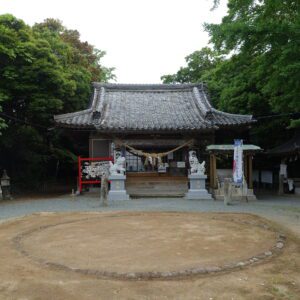

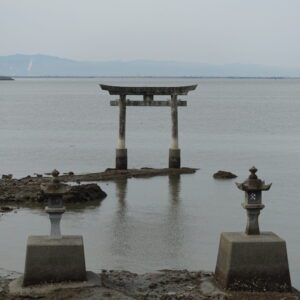

The precincts of Einoo Tsurugi Shrine (Uki City) are known as a viewing point for the Shiranui phenomenon. It has been designated as a national scenic spot as “Shiranui and Mizushima”. In 2022, the Shiranui phenomenon is scheduled to appear on the night of August 26th.
I headed to Misumi West Port from the “Kappo Ryokan Shoukin-kan” where I was staying. To get to Misumi West Port, we need to change buses at “Misumi Sanko”. During that transfer time, I went to the Misumi Port Ferry Terminal, which is called the “Pyramid of the Sea”. The “Pyramid of the Sea” is a conical building with a diameter of 34m and a height of 25m, which is similar in shape to a snail. There are slopes both inside and outside.
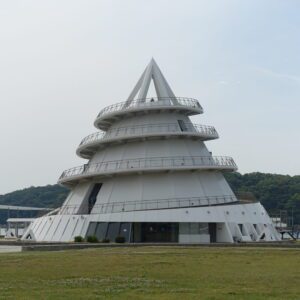

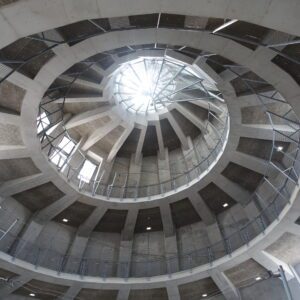

It was a very interesting design building. Designed by Shoei Yoh, an architect born in Kumamoto City. The top light at the top of the cone of the “Pyramid of the Sea” glows at night. Above the “Pyramid of the Sea” was a place with a nice view, and the scenery was very beautiful.
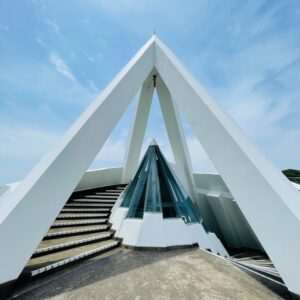

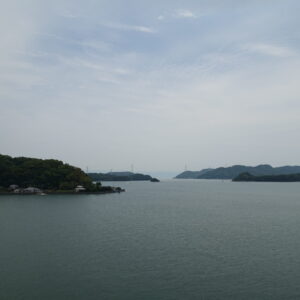

Misumi Station was opened in 1899 and moved to its current location in 1903. It has a long history. Misumi Station is the terminal station of the Misumi Line (nicknamed “Amakusa Misumi Line”). The high-ceilinged wooden station building was built in 1903. We can have a good impression at the station with a calm appearance that seems to be the terminal station.




Misumi West Port was built in 1887 by the Dutchman Rouwenhorst Mulder. It has been designated as a national important cultural property as the only port that has a perfect appearance at the time of its construction. In addition, Misumi West Port is one of the constituent assets of the world heritage “Sites of Japan’s Meiji Industrial Revolution: Iron and Steel, Shipbuilding and Coal Mining”. It has also been selected as a “national important cultural landscape” as a cultural landscape of Misum-iura.


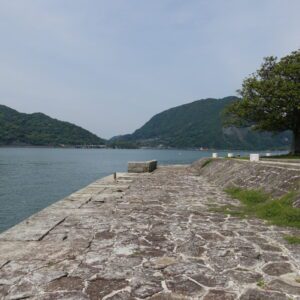

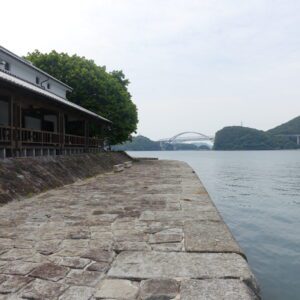

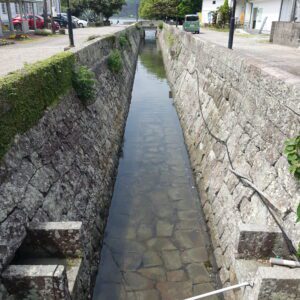

There are many historic buildings around Misumi West Port.
The former Misumi summary court main building was opened in 1890 and later relocated to its current location. It is now being used as a facility to introduce the courtroom.
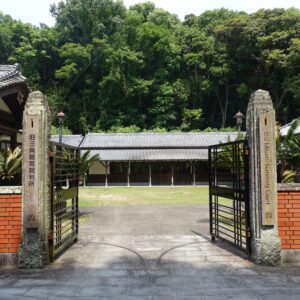

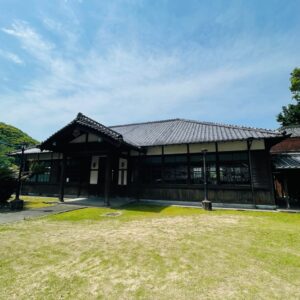



Urashimaya used to be an inn. Lafcadio Hearn stayed in 1893 and loved Urashimaya. In the travelogue “Dream of a Summer Day,” he praised “the inn was a paradise for me, and the maids seemed like celestial maidens.” Currently, it is used as a break room.
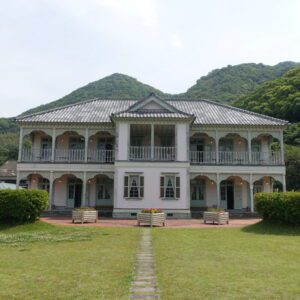

Ryujokan is a wooden one-story Western-style building that was planned to be built in 1918 to commemorate the 50th anniversary of the throne of Emperor Meiji. It is a national designated tangible cultural property. Currently, it is used as an introduction facility for Misumi West Port and the world heritage “Sites of Japan’s Meiji Industrial Revolution: Iron and Steel, Shipbuilding and Coal Mining”.
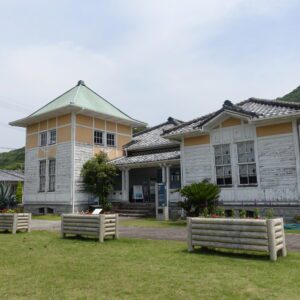

The former Takada shipping agency is an old building that was built in 1887 when the Misumi West Port opened. It is a registered tangible cultural property of Uki City.
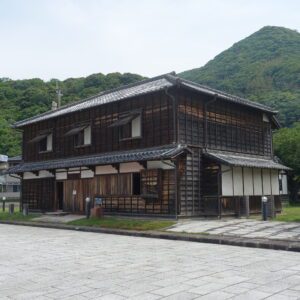

The Misumi Chikko Memorial Hall was built around 1887 and is a dozo building that was used as a warehouse. Currently, it is used as a restaurant called “Nishiko Meijikan”. It is a registered tangible cultural property of Uki City.
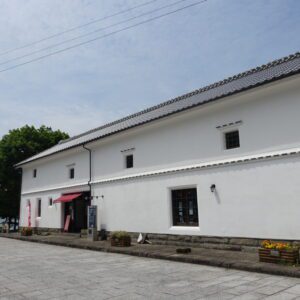

The sightseeing spots around Misumi West Port are small and cohesive, and we can get around in about an hour. It is a recommended sightseeing spot where we can feel the atmosphere of the Meiji era.
From Misumi West Port, I went to the Miike Coal Mine Manda pit.
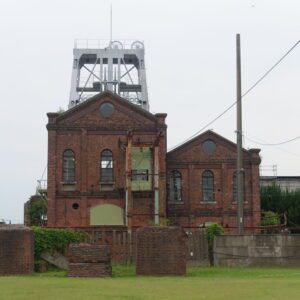

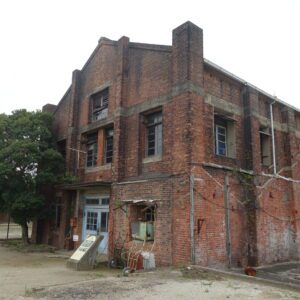

Manda pit is one of the pits of Miike Coal Mine. The main pits of the Miike Coal Mine are scattered in Arao City, Kumamoto Prefecture and Omuta City, Fukuoka Prefecture. The first pit turret of Manda pit was completed in 1899, and the second pit turret was completed in 1908.
Although the mine was closed on March 30, 1997, the facilities at Manda Pit are still very good. The jack engine, winch and hoist are still in their original condition, and we can feel the atmosphere of the Meiji era even if we visit. It seems that the first jack engine in the picture below remains only in Manda pit in the world.
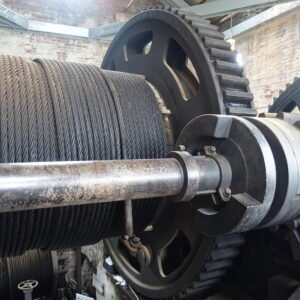

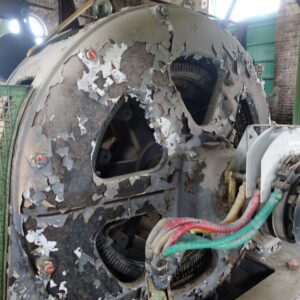

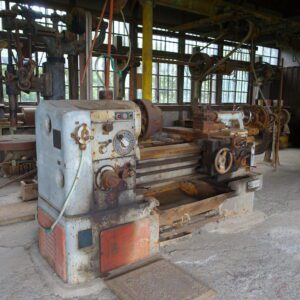

The second pit turret, hoisting machine room, and Yamanogami ritual facility have been designated as national important cultural properties. In addition, it was registered as a World Heritage Site as one of the constituent assets of “Sites of Japan’s Meiji Industrial Revolution”.
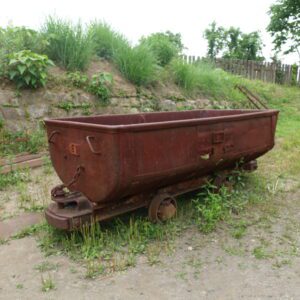



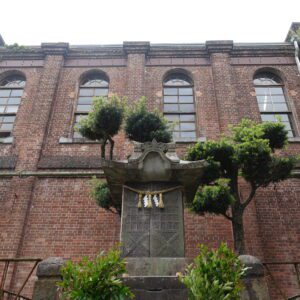

After the Miike Coal Mine Manda pit, I went to the Miike Coal Mine Miyanohara pit. The first shaft of the Miyanohara Pit was completed in 1898 and started coal production. The second shaft was completed in 1901. It is completed slightly earlier than the Manda pit. The Manda pit was closed in 1997, while the Miyanohara pit was closed in 1931, which was significantly earlier. Therefore, the number and scale of the remaining equipment is significantly inferior to that of Manda Pit.
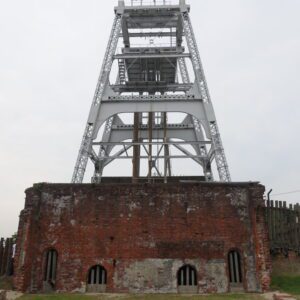



The second shaft turret and hoisting machine room have been designated as national important cultural properties. In addition, it was registered as a World Heritage Site as one of the constituent assets of “Sites of Japan’s Meiji Industrial Revolution”.
There was Kumamon in front of Higo Yokamon Ichiba inside Kumamoto Station and outside the ticket gate of Kumamoto Station.




Meals
I had brunch at Amakusa Champon Chiran near Misumi Station on 19 May. Amakusa Champon is one of Japan’s “Three Great Champons”, along with Nagasaki Champon and Obama Champon. Obama Champon was developed in Obama Onsen (Obama-cho, Unzen City) in Nagasaki Prefecture. If we look up “Three Great Champons”, Tobata chanpon (Tobata Ward, Kitakyushu City, Fukuoka Prefecture) may be mentioned instead of Obama chanpon.
Amakusa Champon is said to have started as an adaptation of Nagasaki chanpon techniques with the addition of Amakusa ingredients. Chiran was opened two years ago by the owner and his wife, who had been in business for many years in Nara Prefecture. Misumi is near owner’s wife home town, Amakusa. This ramen shop was very popular in Nara Prefecture and won the Grand Prix in the variety category of the ramen magazine “Ultimate Ramen 2020”. According to the owner, regular customers of Chiran in Nara sometimes come to Misumi Town, Uki City, to eat there because they cannot forget the taste. The owner and his wife’s friendly personality is probably the secret behind the restaurant’s popularity.
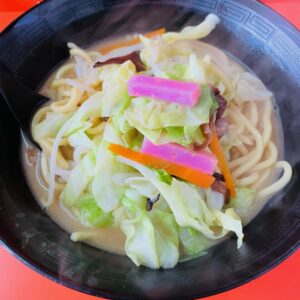

I ordered fried rice (Yen 600) and Amakusa champon with Daioh meat (Yen 900). Daioh meat is the meat of the Amakusa Daioh, one of the largest homebred chickens in Japan. The largest male chicken is 90 cm tall and weighs approximately 7 kg. By the way, broilers weigh around 2 kg. The meat of the Amakusa Daioh is characterised by its juiciness and elasticity, which is neither too hard nor too soft.


The Amakusa Champon at Chiran is characterised by the fact that it contains no seafood at all. The soup was also thick with chicken broth. This thick soup has an addictive taste that I still can’t forget. This ramen shop is located in a fairly small town, Misumi Town, Uki City, but it is certainly a famous restaurant.
I had dinner at HERO KAI, Kumamoto Station Branch, Higo Yokamon Market, Kumamoto Station. I ordered Ichimonji no guruguru (Yen 530), Karashi-renkon : spicy lotus root (Yen 650), Bakudan (Yen 530), vinegared thread Mozuku : Nemacystus decipiens (Yen 530) and a plate of horse sashimi (Yen 1,800). HERO KAI is a izakaya where the president, a native of Ushibuka, Amakusa Islands, Kumamoto Prefecture, serves seafood from Ushibuka and local Kumamoto cuisine. It is a very convenient izakaya for tourists as we can enjoy a variety of seafood and local cuisine.
Kumamoto Prefecture produces the largest amount of horse meat in Japan. Horse sashimi from Kumamoto Prefecture is a famous dish that everyone knows and needs no explanation. The horse sashimi I ate at HERO KAI Kumamoto Station Branch was also very tasty.



I had “Ichimonji no guruguru” for the first time when I travelled to Kumamoto last year and enjoyed it so much that I ordered it again this time. It was so good that I decided to order it every time I come to Kumamoto.



“Karashi-renkon : Spicy lotus root” is a nationally renowned local dish of Kumamoto Prefecture. The origin of “Karashi-renkon” can be traced back to Tadatoshi Hosokawa, the first lord of the Kumamoto Domain in Higo Province. The dish was first presented to Tadatoshi Hosokawa, who was sickly and weak, in order to nourish him, by filling the holes in the lotus root with barley miso mixed with Japanese spicy powder, battering it and deep frying it. As it was a dish for the lord, it was a secret recipe until the end of the Edo period.



“Bakudan” is a speciality of the Amakusa region. A whole boiled egg is placed inside a fish paste. It was a great snack with beer.


“The Vinegared Ito-mozuku” was a refreshing and tasty dish using “Ito-mozuku” from Ushibuka. Incidentally, the “Thick mozuku” that is often caught in Okinawa is a type of mozuku called “Okinawa mozuku”, which is a member of the brown algae family, Pseudochromis nipponica. On the other hand, “Ito-mozuku” is a type of mozuku belonging to the brown algae family Mozuku. “Ito-mozuku” has a soft and smooth texture with a slimy component around the fibres.


For my last meal in Kumamoto, I bought “Ikinari dago” at Kumamoto Souvenirs Shunsaikan and ate it with “Taipien” from Ramen Kusunoki.
“Ikinari dago” were very tasty dumplings, with a sweet red bean paste and a salty dough.



The “Taipien” at Ramen Kusunoki was tasty enough to make it hard to believe that it was eaten at the airport. However, it was not as good as the tasty “Taipien” I was impressed by at Kourantei in Kumamoto City during my trip to Kumamoto last year. Of course, Kourantei is a famous restaurant, so it is inevitable that Ramen Kusunoki is inferior to Kourantei.



After eating “Ikinari dago” and “Taipien”, I headed for Haneda Airport with Dekopon Chuhai on the plane. Dekopon was first produced in the town of Shiranui (now Uki City), where I stayed, as ‘Shiranui’, a hybrid of Kiyomi and Ponkan. Of the Shiranui variety, those with a sugar content of 13 degrees or higher were commercialised and shipped under the name “Dekopon”. Dekopon Chuhai is marketed by the Kumamoto Prefecture Fruit Agricultural Cooperative Federation (Kumamoto Fruit Federation), which holds the trademark “Dekopon”.
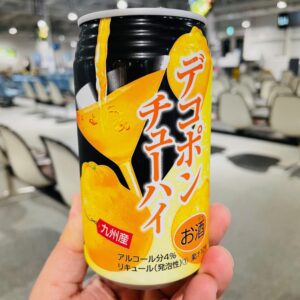

This trip was also very enjoyable. I was glad to be able to visit areas I had never been to before, such as Hitoyoshi City, Yatsushiro City, Uki City and Arao City in Kumamoto prefecture. All were very attractive places.
Important Points
Volunteers guide us for free at Manda pit and Miyanohara pit. However, an admission fee (Adults Yen 410, high school students Yen 310, elementary and junior high school students Yen 210) is charged for Manda pit.
Currently, the Miyanohara pit is undergoing repair work, and it is not possible to tour the inside of the building. Repair work is scheduled to be completed in March 2023.
Kumamoto Airport is currently undergoing renovation work and the new passenger terminal building is scheduled to open in spring 2023.
Note: The departure / arrival times, fares of transportation, admission fees, meal fees, etc. listed in the text are as of the time of writing the BLOG. Please check for yourself when you go on a trip as it may change in the future.
